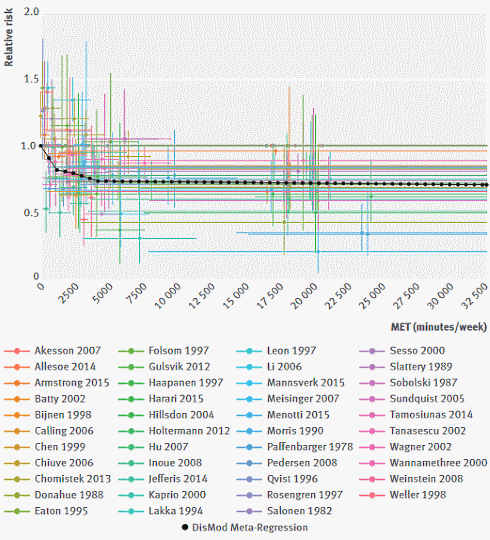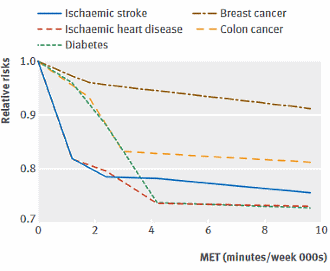|
Definition: "An ergogenic aid is any substance or phenomenon that enhances performance "
|
|
||||||||
20.12.2016 |
|
|
Half an hour exercise a day? Make that three hours...
We hear from scientists and health officers that we should all get at least half an hour of exercise a day to stay healthy. And if you already do that you should try to make that half hour a whole hour. This guideline is on the low side, epidemiologists at the University of Washington report in the BMJ. According to their meta-analysis, our health only really improves if we get two to three hours of physical activity a day.
Study
Health scientists express physical exercise in metabolic equivalent of task minutes and hours, or Met-minutes and -hours.
Results
The figure below shows the effect of physical activity on the chance of heart attack, stroke, breast cancer, bowel cancer and type-2 diabetes.
Conclusion
In rich countries information officers translate that into 30 minutes of activity a day. They assume that inhabitants of those countries are so spoiled that on at least two days a week they do absolutely nothing, not even walking a small distance.
The study published recently in the BMJ suggests that positive health effects will only be gained by doing much more than 600 Met minutes of exercise – somewhere between 3000 and 4000 Met minutes to be exact. So that's seven times more than that half an hour of walking.
"A person can achieve 3000 metabolic equivalent minutes per week by incorporating different types of physical activity into the daily routine", explained first author Hmwe Kyu in an interview with The Guardian, an English newspaper. [theguardian.com 9 August 2016]
"For example, climbing stairs for 10 minutes, vacuuming for 15 minutes, gardening for 20 minutes, running for 20 minutes, and walking or cycling for transportation for 25 minutes, on a daily basis, would together achieve about 3,000 metabolic equivalent minutes a week."
In practice only athletes and people who do physical work are likely to attain the optimal amount of physical activity.
Source:
More:
Archives: |
|


